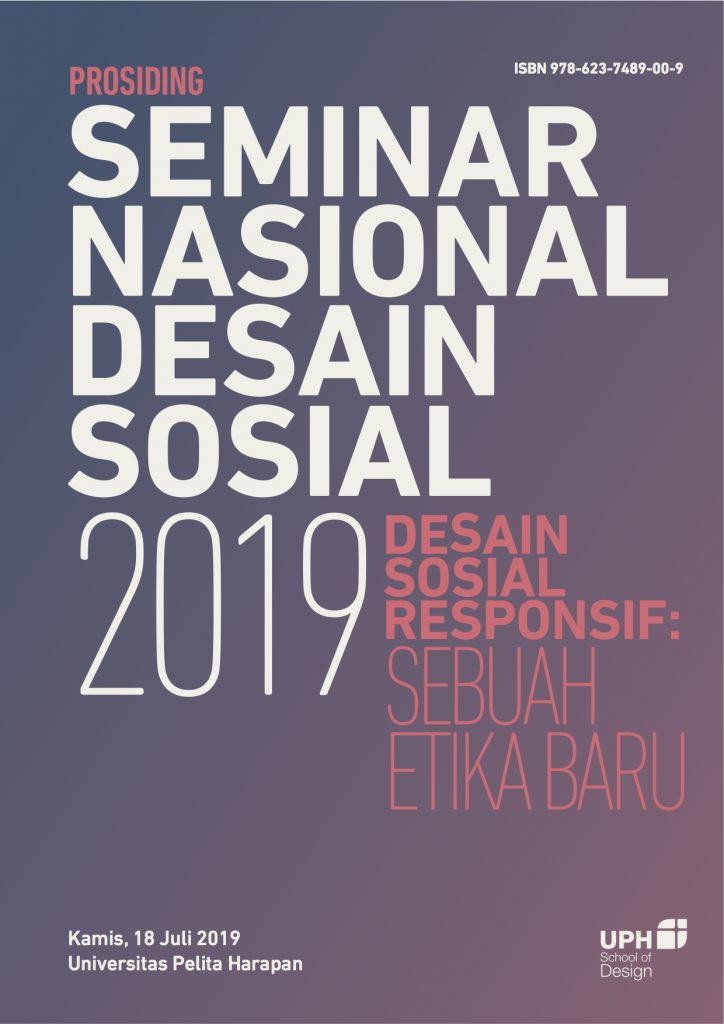Membangun 'Nabung Aer Next' - Platform Kesadaran Konservasi Air
Abstract
Persediaan air bersih, terutama air tanah selalu menjadi permasalahan. Program Studi Desain Interior, Fakultas Desain, Universitas Pelita Harapan (UPH) semenjak tahun 2015 telah bekerja sama dengan komunitas Design as Generator (DAG) menginisiasi berbagai kegiatan untuk membangkitkan kesadaran mengonservasi air melalui kegiatan dengan nama Nabung Aer - NA di berbagai kampung, komunitas, sekolah hingga daerah pedalaman. Berdasarkan apa yang telah dilakukan bersama tersebut, komunitas Design as Generator (DAG) bersama Program Studi Desain Interior, Fakultas Desain, Universitas Pelita Harapan (UPH) bekerja sama mengembangkan platform untuk membangun kesadaran masyarakat terhadap pentingnya konservasi air yang diberi nama NA NEXT Platform. Hal yang ditemukan dari inisiasi ini adalah bahwa untuk membangun kesadaran yang efekif melalui media platform, maka di masa sekarang ini harus menggunakan 2 pendekatan: digital platform dan physical event yang berjalan beriringan.
References
Katoppo, Martin L. (2017). DESAIN SEBAGAI GENERATOR PEMBERDAYAAN MASYARAKAT. Disertasi Program Doktor, Institut Teknologi Bandung.
Simonsen, J. dan Robertson, T. (2013). Routledge International Handbook of Participatory Design. New York & London: Routledge International Handbooks.
Greenbaum, J. dan Loi, D. (2012). Participation, the camel and the elephant of design: an introduction. CoDesign: International Journal of CoCreation in Design and the Arts. 8, 2-3, 81-85.
Jenkins, P. dan Forsyth, L. (2010). Architecture, Participation and Society, New York : Routledge.
Jones, P. B., Petrescu, D., dan Till, J. (2005). Architecture and Participation. New York: Spon Publishing.
Sanoff, H. (2000). Community participation methods in design and planning. Canada: John Wiley & Sons, Inc.
Brown, T. dan Katz, B. (2009). Change by design: how design thinking transforms organizations and inspires innovations. New York: HarperCollins Publishers.
Brown, T., dan Wyatt, J. (2010). Design thinking for social innovation. Stanford Social Innovation Review, Stanford School of Business: 29-35.
IDEO (2013). Human centered design (HCD) toolkit: design thinking toolkit for social innovation project, 2nd.ed. Licensed under The Creative Commons Attribution, Non Commercial, Share A-Like 3.0 Unported License, with IDE, Heifer international and ICRW, funded by Bill and Melinda Gates Foundation.
Katoppo, M. L., dkk. (2014). Design as Generator (DAG): an architectural approach for empowering community (republished as Design as Generator (DAG): an architectural approach for empowering community). DIMENSI Journal of Architecture and Built Environment 2:41: 85-94.
Katoppo, M. L. dan Sudradjat, I. (2015). Combining Participatory Action Research (PAR) and Design Thinking (DT) as an alternative research method in architecture. Procedia - Social and Behavioral Sciences 184 C (2015): 118-125.
Katoppo, M. L., Triyadi, S., dan Siregar, M. J. (2017). Memory, hope and ssense - Design as Generator (DAG) premises for empowering community. Advanced Science Letters Vol.23 No.7. 6095-6101.
Katoppo, M. L., Triyadi, S., dan Siregar, M. J. (2015a). Design as Generator (DAG) - an action design research exploration for empowering community through sustainable design interventions. The 6th International Conference on Sustainable Future for Human Security (SustaiN) 2015: Sustainable Development and Global Change. hosted by SustaiN Society: Bali.
Laporan MK. DSE TA 2017/2018 Semester Akselerasi: NA NEXT bersama Sekolah Alternatif Anak Jalanan (SAAJA) dan Design as Generator (DAG)
http://thejakartapost.com/news/2018/07/07/ residents-encouraged-save-water-through- biopores-system.html
Neuman, L. W. (2006). Social research methods - qualitative and quantitative approaches. Boston, NY, SF: Pearson Education, Inc.
Creswell, J. W. (3rd ed. © 2008, 2005, 2002): Educational research - planning, conducting, and evaluating quantitative and qualitative research. New Jersey: Pearson Education. Inc, Pearson International Edition.




.png)
.png)
